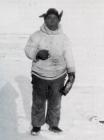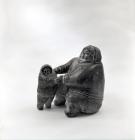2
Akeeaktashuk [1898-1954]His story
Akeeaktashuk's "immense talent as a stone carver was immediately recognized," wrote Frederica Knight, who lived in the Canadian Arctic for 30 years (from 1934 to 1964) as the wife of a Hudson's Bay Company factor. In a 1955 article for The Montrealer, Wanda Tolboom wrote that Akeeaktashuk "preferred to recline in his igloo carving replicas of birds or animals out of soapstone or ivory. Sometimes he made distorted but easily recognizable images of the other natives and gave them to the children as playthings." Darlene Wight, curator of Inuit art at the Winnipeg Art Gallery, noted that "he is considered to be the most prolific carver from the early period of Inuit art" (2006: 29).
He quickly rose as a star in the early 1950s, receiving attention in books and publications, including Town & Country magazine (November 1983). He was referred to as an "Arctic Angelo" by Frank Lowe, a writer for The Montreal Daily Star (1950). In 1950, his sculpture of an Inuit hunter was selected by James Houston to be the highlight in a display of carvings that he was sending to New York. Before it could be sent, however, the carving was accidentally sold in Montreal: "The rush of Montrealers for these curious and beautiful examples of Eskimo culture surprised Jim [Houston]. They swarmed into the Canadian Handicraft Guild shop at 2025 Peel Street in such numbers that somehow the prized Akeeaktashuk carving was sold, too," wrote Lowe in 1950.
Akeeaktashuk was one of several Inuit who were relocated to present-day Grise Fiord in 1953 by the Canadian government in order to lay claim to the North during the Cold War (Wight 1990:85). He died in a hunting accident in Grise Fiord in 1954.
His art
Akeeaktashuk's hunting narratives were particularly appreciated. Wight thinks that his "later carvings reflect a stylistic change." For instance, he began using white and black concentric circles to represent eyes, instead of the horizontal slashes characteristic of his earlier works (1990:85). Akeeaktashuk's work was shown in the 1953 exhibition (also known as the "Coronation Exhibition") at Gimpel Fils Gallery in London, England and it is found in many private and public collections throughout North America.
References
Knight, Frederica
1990 "Arctic Quebec," First Passionate Collector. Winnipeg: Winnipeg Art Gallery.
Lowe, Frank
1950 The Montreal Daily Star, Montreal, 9 August.
Tolboom, Wanda Neill.
"Akeeaktashuk-Eskimo Carver." The Montrealer, October 1955, quoted in 2006, Darlene Wight, Early Masters: Inuit Sculpture 1949-1955. Winnipeg: The Winnipeg Art Gallery:30.
Wight, Darlene
2006 Early Masters. Winnipeg: Winnipeg Art Gallery.
1990 "The Handicrafts Experiment 1949-1953," First Passionate Collector. Winnipeg: Winnipeg Art Gallery.
3
"Box with Animal Heads" by Akeeaktashuk (attr.)1950
Inukjuak, Quebec, Canada
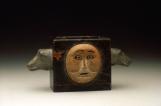 Credits:
Credits:Photo: National Film Board
4
"Mother and Child" by Akeeakstashuk1953
Inukjuak, Quebec, Canada
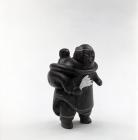 Credits:
Credits:Photo: National Film Board
5
"Mother and Child" by Akeeaktashuk1953
Inukjuak, Quebec, Canada
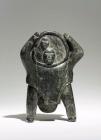 Credits:
Credits:Photo: Ernest Mayer, Winnipeg Art Gallery
